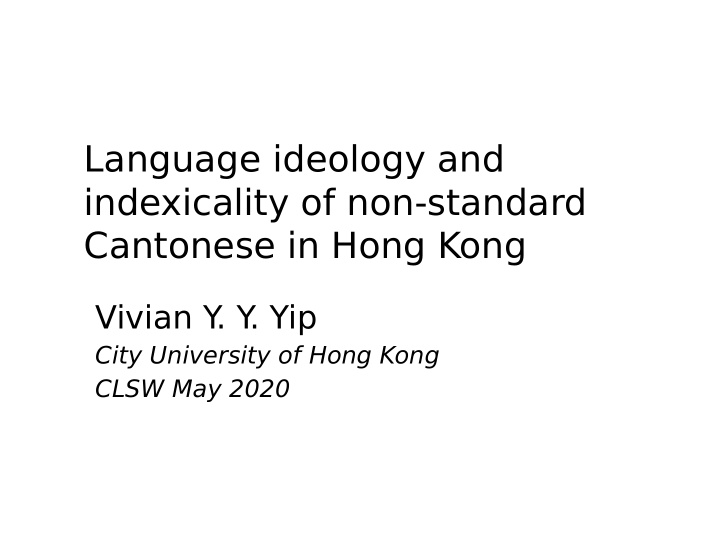



Language ideology and indexicality of non-standard Cantonese in Hong Kong Vivian Y . Y . Yip City University of Hong Kong CLSW May 2020
Introduction Language ideology: • A mediating link between social structures and speech (Woolard, 1998) • One nation, one language • One variety chosen as standard, all the other varieties considered as non-standard • Ideological link between standard language & national power
Introduction Aim of this paper: • Go beyond the simple dichotomy of standard and non-standard language • Reveal the ideological link between non-standard variety and national power
Presentation: • Sociolinguistic situation in HK • The advertisement • Analysis of the video production • Analysis of metalinguistic comments
Background Clear language hierarchy • English, prestige due to the colonial history • Cantonese, non-standard status yet used in offjcial capacities (such as the government’s offjcial speech & debates in Legislative Council) • Putonghua, offjcial language at national level
Background Cantonese • carries a local prestige • is essential for immigrants to increase their employability the Hong Kong case of a non-standard variety of the non-standard language is a unique phenomenon Focus: Non-standard variety spoken by female “new immigrants” who came after the Handover in 1997 for family reunion
The advertisement Advertisement: • “The Rap of T amJai” • produced by a local satirical online TV channel TVMost • for a local chained noodle shop TamJai
The advertisement The video: https://www.youtube.com/watch?v=l2 Q2BBNY7YI • Fictional & real life situation • Natural & unnatural language
Analysis of the video production • The imagined “accented” Cantonese to the imagined social group Examples of phonological variations between “standard” and “non-standard” Cantonese: 1. “lack” – 欠缺 [him3 kyut3] vs * 獻缺 [hin3 kyut3] 2. “server”– 侍應 [si6 jing3] vs * 侍燕 [si6 jin3] 3. “no change”– 不變 [bat1 bin3] vs * 巴變 [baa1 bin3] • This type of written data, as mock standardisation, contributes to the creation and reinforcement of a stereotype towards the new immigrants.
Analysis of the metalinguistic comments • “orders of indexicality” of Silverstein (2003) - indexicality is the phenomenon of a sign pointing to (or indexing) some object in the context in which it occurs. - The reference can shift from context to context 1. Indexical of pejorative evaluation: “inaccurate” ( 唔正 ) “rubbish” ( 垃圾 ) “rural” ( 鄉 ) “not-salty-not-bland” ( 唔鹹唔淡 ) – not up to standard
Analysis of the metalinguistic comments 2. Indexical of “outsider” “we natively born and raised” ( 我哋 土生土長 ), “Hong Konger” ( 香港人 ), “local” ( 本地 ) = self / standard in contrast with “new immigrants” ( 新移 民 ),“mainlanders” ( 大陸人 ), “dama” ( 大媽 ) = other / non-standard
Analysis of the metalinguistic comments • Negative evaluation based on social factors : FB#13025 (…) 李嘉誠嚟咗香港幾十年,廣東話 都講唔正就得;大陸人努力工作唔攞綜援,廣東話 講唔正就唔得… (…)Li Ka-shing has come to Hong Kong for a few decades, speaks inaccurate Cantonese is okay; Mainlanders work hard and not depend on social welfare, speak inaccurate Cantonese is not okay…
Analysis of the metalinguistic comments 3. Indexical of China the national power • Indirect notions to refer to China “Central Communist government” ( 中共 ) , “mainland” ( 大陸 ) , “sad together party” ( 共慘黨 ) , “Shina” ( 支拿 )
Analysis of the metalinguistic comments • Indexical of China the national power - caused by incidences in Hong Kong related to the Chinese government - a sign of mainlandisation of Hong Kong - non-respect of the “one country, two systems” principle - driven from a bottom-up process by the online comments of lay people
Conclusion • The dichotomy of “standard” and “non- standard” language is within the substandard level: “standard” and “non-standard” Cantonese • Social stigmatisation depends more on social factors instead of linguistic factors • geographical overlapping fact of origin of new immigrants and Chinese government has contributed to occurrence of non-standard language as an indexical of the national power, China
Recommend
More recommend